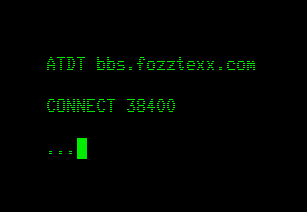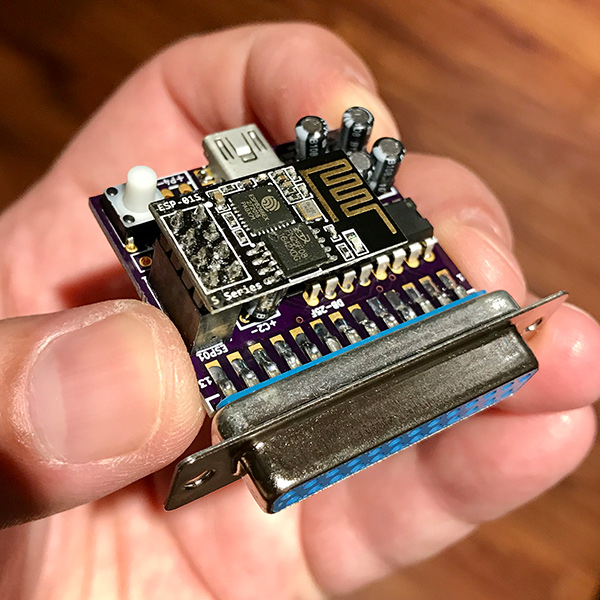 Over the past year or so, I’ve been loading up SyncTerm and logging in to various telnet-accessible BBSs here and there — nothing too consistent. But, thanks to a piece of kit released by Paul Rickards, over the past month I have become fully immersed in the telnet BBS scene. Paul’s WiFi232 Internet Modem is an inexpensive device that lets you BBS the way it was meant to be done, on hardware from the golden age of the Bulletin Board System.
Over the past year or so, I’ve been loading up SyncTerm and logging in to various telnet-accessible BBSs here and there — nothing too consistent. But, thanks to a piece of kit released by Paul Rickards, over the past month I have become fully immersed in the telnet BBS scene. Paul’s WiFi232 Internet Modem is an inexpensive device that lets you BBS the way it was meant to be done, on hardware from the golden age of the Bulletin Board System.
In a nutshell, it works like this: The WiFi232, as far as your vintage computer is concerned, is a Hayes telephone modem. It accepts standard AT commands as well as AT commands that go rather beyond the standard Hayes commandset. The purpose of the device is to act as a bridge between your serial port and your local WiFi router. It has a 25-pin RS-232 data interface and a Mini-USB connector for power — it should work with any computer sporting a standard serial port.
 The WiFi232 is configured by connecting to the device’s built-in web server and loading the configuration page or by issuing extended AT configuration commands. For example,
The WiFi232 is configured by connecting to the device’s built-in web server and loading the configuration page or by issuing extended AT configuration commands. For example,
AT$SSID=MyWifiHotspotName
points the device to your WiFi hotspot. Once things are configured (it supports 300 to 115,200 baud), just load up your favorite terminal program, type:
ATDT bbs.myfavbbs.com
and the WiFi232 “dials” into that telnet BBS. Your vintage computer thinks its talking on the phone.
I had early access to the device (well, I have two) and have been enjoying them on my Apple //c at the office as well as my enhanced Apple IIe, Amiga 1000, and TI-99/4A (recently upgraded to 80-columns with an F18a FPGA video board (that’s a blog post for later)) at the house. The WiFi232 is easy to move around, works exactly as advertised — it is an oldschool modem to my vintage systems — and gives me a compelling, new reason to spend time on a variety of machines in my collection.
I hope the demo video I put together gives a taste of what the WiFi232 enables, and I wholeheartedly recommend that any vintage computing fan grab one and get back online.
Here’s a list of telnet BBSs to get you started.
UPDATE: The WiFi232 device is no longer being manufactured. See my BBSing resource page for a list of alternative devices for a variety of platforms.

Pingback: Byte Cellar shows retro machines accessing BBS’es via Internet with the new WiFi232 – Vintage is the New Old
What a cool retro project !!
Is there a list to get an announcement when it is available again? It says it is sold out now.
Yes, I’ve added a link to get notified if I do another run. Thanks! http://biosrhythm.com/?page_id=1453
I hope you do, I really wanted to grab one!
Same here.
If you ever do another run, consider adding a box to it, as it would make the finished product so much better!
That is a very clever idea, and one that would not have occurred to me. I like their decision to go with an extended AT command set.
Oh my!
I now HAVE to find a working AtariST or Commodore64 to make our old Haltsys! BBS back “online”.
Congrats for a fine, clever and nostalgy-inducing project.
Hand me a tissue, please.
Wow… This is the real hacking!
Pingback: 1 – The Wonderful WiFi232: BBSing Has (Literally) Never Been Easier
What is the maximum bandwidth? Is it limited to modem speed or Wifi?
Do you know of any software you can run on another machine that would let you “dial” to it to access the internet?
I’m also curious if there is sufficient software to allow you to transfer files between machines, (Amiga -> Modern OS) as an alternative to an ethernet adapter.
The maximum bandwidth is dictated by the RS-232 serial speed that you’ve set. Currently that’s between 300 and 115200 baud.
To transfer files, you can use a terminal program on the Amiga (NComm, JRComm, etc) and something like SyncTERM on the modern OS computer. SyncTERM can dial an IP address. Once connected, use ZModem to transfer files to the Amiga (or vice versa).
Put the kit version of this together over the weekend. With the exception of the surface mount USB socket, which was a bit fiddly, the construction went ok, and it worked great. The user instructions were clear and I got “online” via my Macbook with a USB->serial adapter quickly. I have a number of retro machines where this will find a good home.
Any chance you could post the source code?
Pingback: BBSing with the ESP8266 | Hackaday
Pingback: BBSing with the ESP8266 – High Tech Newz
Pingback: BBSing with the ESP8266 – KAYENRE Technology
Here’s two videos showing how it is possible to encapsulate full tcp/ip traffic over WiFI232 using ppp:
https://www.youtube.com/watch?v=S-Pql1hpmzE
https://www.youtube.com/watch?v=dUDpsMBa8jY
Pingback: A tiny Hayes modem for your tiny retro computer - Lmdevs
Pingback: A tiny Hayes modem for your tiny retro computer – SaleSpree.com blog
Pingback: A tiny Hayes modem for your tiny retro computer – Alyssa Fields
Pingback: A tiny Hayes modem for your tiny retro computer – Tess Kimball Blog
Does it support SSH?
If you encapsulate ppp over it as described in this video, yes, you should be able to do ssh on top of it, provided you have an ssh client on the client computer you’re connecting with:
https://www.youtube.com/watch?v=S-Pql1hpmzE
Pingback: A tiny Hayes modem for your tiny retro computer / Boing Boing
Pingback: A tiny Hayes modem for your tiny retro computer – pintfy
Pingback: A tiny Hayes modem for your tiny retro computer - Puffin Computers
But what if Your vintage computer… don’t have a serial. And no I don’t mean last year laptop with USB 3.0 on board. For example there is a Polish Elwro 800 Jr computer, which have printer port, local Junet network ports, and usual – joystick(similar to Atari or Kempston one), RGB, monitor(composite style signal).
Operating system is CP/M and Spectrum compabitible.
I am sure someone could wire something together using the printer or Junet ports to get it working using custom software with the WiFi232. It would be a non-simple project, but an interesting challenge.
If users are following this thread, there is also a WiModem232 very similar to this design. I know the author of that firmware has made some updates not present in this version. His website is at http://www.CBMStuff.com . He has two versions, one with an LED display, and one without.
Pingback: Modern-Day BBSing on the Epson PX-8 CP/M Laptop, Circa 1984 | Byte Cellar
Pingback: Quickie: A Little PETSCII BBS Fun on a Saturday Morning | Byte Cellar
Here is also a cool alternative to anyone waiting for one of Paul Rickards’ awesome wifi232s:
https://www.simulant.uk/shop/retro-vintage-computer-wifi-modem-rs232-serial-hayes-compatible
Opensource firmware and comes with a case too. :)
Pingback: A Unique Work of Art for My Office in D.C. | Byte Cellar
Pingback: Putting the Atari ST and TI out front for “Modern Touch Week” at r/Retrobattlestations | Byte Cellar
Pingback: ‘Twas No Post, But Poetry! (At 300 Baud) | Byte Cellar
Stumbled onto the site..glad I did and bookmarked it. An onboard RS232 port was never available for the Timex/Sinclair line of computers, however, there were some a third party RS232 peripherals available. I am not sure if the Sinclair Spectrum RS232 interfaces were compatible with the Timex/Sinclair ones because the pinouts on the card edge connector were not quite the same. The Timex 2050, 300 baud modem was available from Timex as well as the Westridge modem boards by a several vendors back in the day, say …1983. Timex stuck the modem contractor with unsold inventory when they exited the computer scene. There was a modification to those boards that would make them into an RS232 interface. I stumbled across a page of Amstrad periphials here on this site that were interesting, especially the multibackplane board. It looks a lot like one that I have from the Timex Waterbury R&D computer division prototyped.
Pingback: Looking Back on 35 Years as an Amiga User - Byte Cellar
Pingback: BBSing in the Snow Is the Best Way to Login - Byte Cellar
Pingback: Configure Your Mac to Allow Vintage Computers to “Dial In” - Byte Cellar
Pingback: "MuffinTerm": A Great New Terminal Emulator for iPhone, iPad, and Mac - Byte Cellar
Pingback: 3 – “MuffinTerm”: A Great New Terminal App for BBSing on iPhone, iPad, and Mac - Wazooy Startups